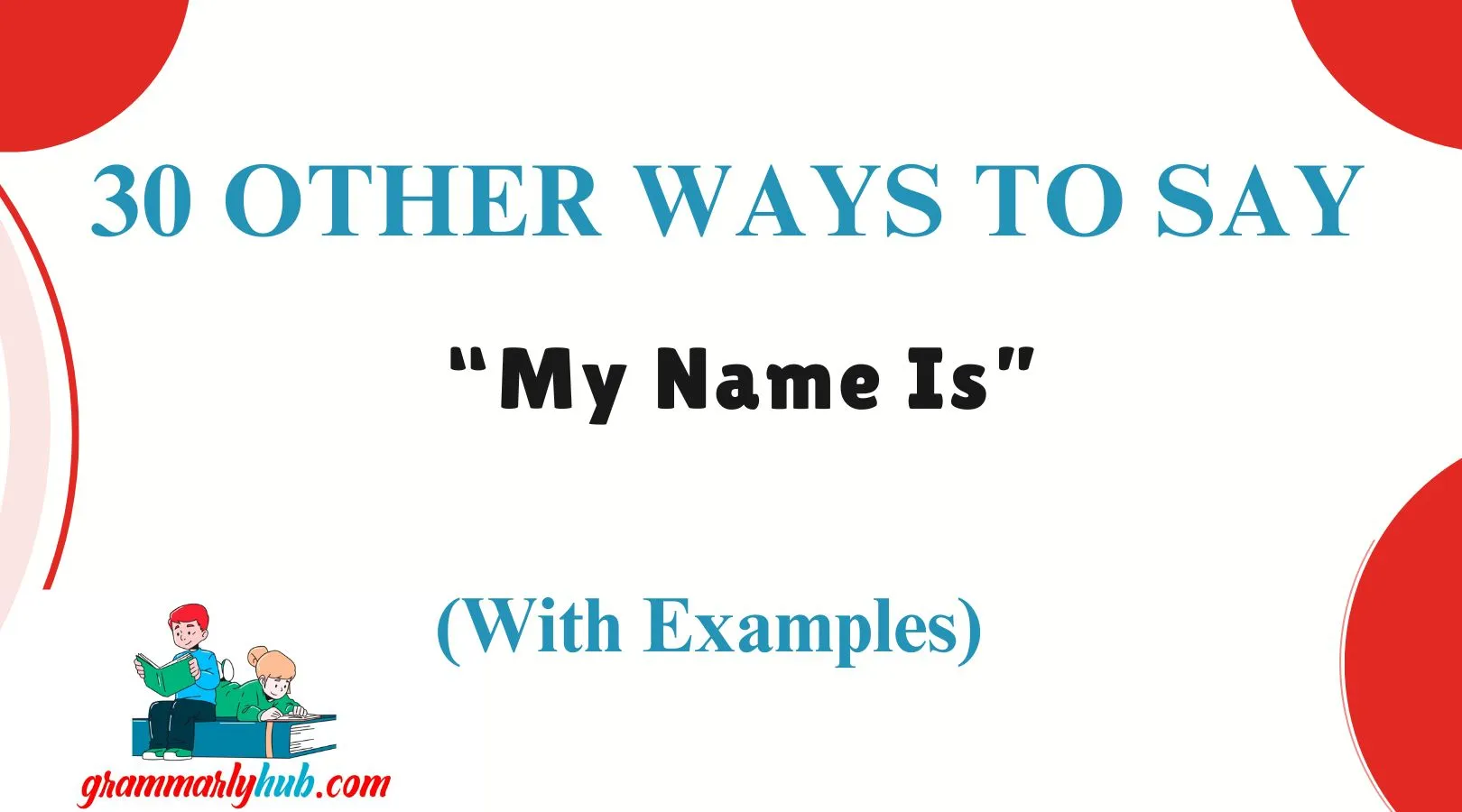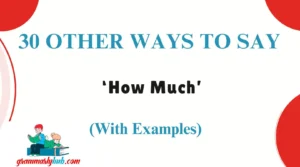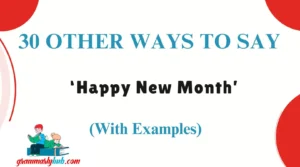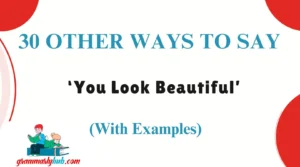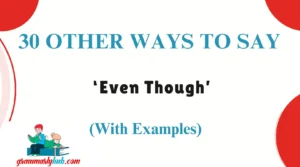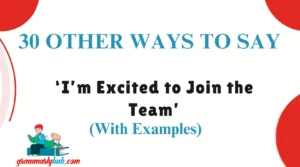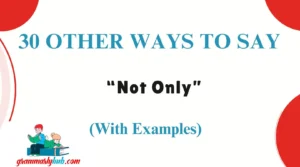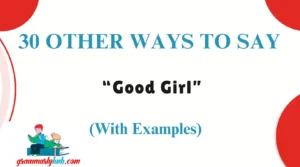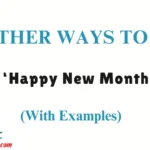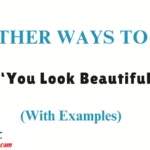Introducing yourself can be more than just stating your name—it’s about making a connection and communicating your identity in a way that feels warm and meaningful. Whether you’re introducing yourself in a casual setting, a professional environment, or even trying to stand out in a creative context, there are many ways to express yourself.
By exploring different alternatives to the phrase “My name is,” you can add a touch of personality, charm, or professionalism to your introduction. In this article, we’ll explore 30 alternative ways to say “My name is,” offering examples, tips, and guidance on when each option is most appropriate. Let’s dive in!
What Does “My Name Is” Mean?
“My name is” is a straightforward, common phrase used to introduce oneself to others. It’s simple and direct, but it might not always feel personal or impact, especially in a world where communication can be as much about emotion and connection as it is about information.
Sometimes, finding an alternative can allow you to express yourself more authentically and connect with others in a deeper way.
When to Use “My Name Is”
While “My name is” is a universally understood phrase, it’s often used in formal or basic introductions. This is perfect in settings where simplicity is valued, like filling out a form, meeting someone for the first time in a neutral environment, or introducing yourself in professional emails.
However, to elevate your interactions, exploring alternative phrases can add a level of warmth, friendliness, or professionalism, depending on your goal.
Is It Professional/Polite to Say “My Name Is”?
Yes, it is entirely professional and polite to say “My name is.” It’s a common, formal way to introduce oneself in both personal and professional settings. However, depending on the environment and the relationship you’re establishing, there may be other, more nuanced ways to introduce yourself that add a personal touch or better align with your audience’s expectations.
Pros and Cons of “My Name Is”
Pros:
- Simple and widely understood.
- Appropriate for almost every setting.
- No ambiguity—everyone knows exactly what you’re saying.
Cons:
- Lacks personality and warmth.
- Can sound too formal or impersonal in certain situations.
- May not convey enthusiasm or emotion in more creative or informal settings.
Synonyms for “My Name Is”
- I’m [Your Name]
- You can call me [Your Name]
- I go by [Your Name]
- People call me [Your Name]
- My full name is [Your Full Name]
- I’m known as [Your Name]
- I prefer to be called [Your Name]
- I answer to [Your Name]
- They call me [Your Name]
- I’m also known as [Your Name]
- My friends call me [Your Name]
- I’m referred to as [Your Name]
- I’m [Your Name], pleased to meet you
- Call me [Your Name]
- I’m commonly called [Your Name]
- I use [Your Name] for business
- I’m officially known as [Your Name]
- You may refer to me as [Your Name]
- The name’s [Your Name]
- I’m [Your Name] by the way
- Some people know me as [Your Name]
- I like to be called [Your Name]
- I go by the name [Your Name]
- In case you’re wondering, I’m [Your Name]
- It’s [Your Name], nice to meet you
- I’m known in some circles as [Your Name]
- Let me introduce myself, I’m [Your Name]
- My colleagues call me [Your Name]
- Everyone calls me [Your Name]
- I’m the one and only [Your Name]
1. “I’m [Name]”
Definition: A casual and informal way of introducing yourself.
Explanation: This phrase is slightly more relaxed than “My name is” but still communicates who you are.
Scenario Example: At a party, you might say, “I’m Sarah, nice to meet you!”
Worst Use: In very formal settings, like business meetings or interviews.
Tone: Friendly, casual, and approachable.
2. “They call me [Name]”
Definition: A fun, informal way to introduce yourself, often with a nickname or nickname-based introduction.
Explanation: This version adds personality and suggests that you may go by a more familiar name.
Scenario Example: “They call me Max, but my real name is Alexander.”
Worst Use: In professional or formal settings.
Tone: Casual, approachable, with a hint of humor.
3. “You can call me [Name]”
Definition: A slightly more relaxed way of suggesting a name you prefer to be called.
Explanation: This is ideal when you’re giving someone the choice of what to call you.
Scenario Example: “You can call me Lisa, I like to keep it simple!”
Worst Use: In very formal or official settings where using a full name is expected.
Tone: Friendly, open, and accommodating.
4. “I go by [Name]”
Definition: A subtle way to introduce yourself, especially if you prefer a specific name or variation.
Explanation: This allows you to present yourself in a way that feels natural to you without directly stating “My name is.”
Scenario Example: “I go by Jake, but feel free to use my full name, Jacob, if you prefer.”
Worst Use: In formal settings where a professional introduction is expected.
Tone: Casual, approachable, and flexible.
5. “Call me [Name]”
Definition: A confident and straightforward way of offering your name.
Explanation: This version is direct, but with a touch of personality and ease.
Scenario Example: “Call me Chris, I’m excited to meet you!”
Worst Use: In highly formal or conservative settings.
Tone: Confident, direct, and easygoing.
6. “I am [Name]”
Definition: A slightly formal yet simple way to introduce yourself.
Explanation: It’s a direct approach, just like “My name is,” but without the extra wording.
Scenario Example: “I am David, nice to meet you!”
Worst Use: In extremely casual or informal settings.
Tone: Neutral, polite, and professional.
7. “Hi, I’m [Name]”
Definition: A combination of casual and warm, ideal for informal introductions.
Explanation: The greeting “Hi” makes this feel welcoming while still providing your name.
Scenario Example: “Hi, I’m Maria! It’s so great to meet you!”
Worst Use: In highly formal or corporate settings.
Tone: Friendly, welcoming, and approachable.
8. “I’m known as [Name]”
Definition: A way to introduce yourself, particularly when you’re known by a nickname or alternate name.
Explanation: It suggests you have a known persona that differs from your formal name.
Scenario Example: “I’m known as Sam, but my full name is Samantha.”
Worst Use: In situations where your formal name is required.
Tone: Casual, relaxed, and informal.
9. “The name’s [Name]”
Definition: A slightly more dramatic or confident way of introducing yourself.
Explanation: This version often implies a sense of self-assuredness, almost like introducing a persona.
Scenario Example: “The name’s John, but you can call me Jack!”
Worst Use: In overly professional or stiff settings.
Tone: Confident, bold, and engaging.
10. “I prefer to be called [Name]”
Definition: A polite way to specify your preferred name.
Explanation: This version is especially useful if you have a nickname or a different version of your name you like better.
Scenario Example: “I prefer to be called Ellie, even though my full name is Eleanor.”
Worst Use: In casual, non-formal environments where simplicity is key.
Tone: Respectful, polite, and thoughtful.
11. “You can call me [Name], but my full name is [Full Name]”
Definition: An introduction that offers a choice between your preferred name and your full name.
Explanation: This is useful if you have a formal name but prefer a more casual one.
Scenario Example: “You can call me Greg, but my full name is Gregory.”
Worst Use: In environments where brevity is preferred.
Tone: Informal, flexible, and considerate.
12. “It’s [Name]”
Definition: A very direct and succinct way to introduce yourself.
Explanation: This version is perfect for more casual settings where you don’t need a formal greeting.
Scenario Example: “It’s Peter.”
Worst Use: In more formal or polite settings where a longer introduction is appropriate.
Tone: Direct, simple, and efficient.
13. “My friends call me [Name]”
Definition: A casual and relatable introduction, often used to give a sense of familiarity.
Explanation: This version suggests a connection with friends or a more informal relationship.
Scenario Example: “My friends call me Lou.”
Worst Use: In highly formal settings where a professional introduction is expected.
Tone: Warm, approachable, and easygoing.
14. “I’m [Name], and you are?”
Definition: A friendly introduction that also invites the other person to share their name.
Explanation: This version adds a conversational element to your introduction, showing interest in the other person.
Scenario Example: “I’m Emma, and you are?”
Worst Use: In professional settings where a more formal tone is required.
Tone: Friendly, engaging, and conversational.
15. “Name’s [Name], nice to meet you!”
Definition: A direct yet welcoming way to introduce yourself.
Explanation: The addition of “nice to meet you” softens the introduction and adds warmth.
Scenario Example: “Name’s Jack, nice to meet you!”
Worst Use: In formal or corporate meetings where formality is preferred.
Tone: Confident, welcoming, and friendly.
16. “I’m the one and only [Name]”
Definition: A playful and confident introduction, often used in more informal settings.
Explanation: This adds a sense of uniqueness to your name and can spark curiosity.
Scenario Example: “I’m the one and only Sam!”
Worst Use: In formal settings where professionalism is crucial.
Tone: Playful, confident, and lighthearted.
17. “Let me introduce myself—[Name]”
Definition: A more formal, yet still warm, way to introduce yourself.
Explanation: This version works well in professional contexts, where a more polished introduction is desired.
Scenario Example: “Let me introduce myself—Catherine.”
Worst Use: In highly casual settings or small social gatherings.
Tone: Polite, formal, and courteous.
18. “I’m [Name], and I’m happy to be here”
Definition: An introduction that expresses enthusiasm and gratitude.
Explanation: This shows warmth and positivity, making you approachable and open.
Scenario Example: “I’m Rachel, and I’m happy to be here!”
Worst Use: In stiff, formal, or highly professional settings.
Tone: Warm, enthusiastic, and welcoming.
19. “Here’s [Name]”
Definition: A simple and straightforward introduction.
Explanation: This version skips the typical pleasantries and gets right to the point.
Scenario Example: “Here’s Alex!”
Worst Use: In highly formal or reserved settings.
Tone: Direct, casual, and matter-of-fact.
20. “I’m the person known as [Name]”
Definition: A formal yet interesting way to introduce yourself, adding a bit of intrigue.
Explanation: This version works well when you want to stand out and catch attention.
Scenario Example: “I’m the person known as Sarah.”
Worst Use: In more traditional or straightforward environments.
Tone: Formal, intriguing, and bold.
21. “I’m [Name]—you might have heard of me!”
Definition: A playful and slightly self-assured way of introducing yourself.
Explanation: This adds humor and personality to the introduction, suggesting that you may be well-known or have a unique presence.
Scenario Example: “I’m Chris—you might have heard of me!”
Worst Use: In formal or professional settings.
Tone: Confident, playful, and humorous.
22. “I’d like to introduce myself—[Name]”
Definition: A formal yet personal way of presenting yourself.
Explanation: This works well when you want to give a more polished introduction without sounding too stiff.
Scenario Example: “I’d like to introduce myself—Ella.”
Worst Use: In very casual or informal settings.
Tone: Polite, respectful, and formal.
23. “I’m [Name]—pleasure to meet you”
Definition: A polite and warm way to introduce yourself with a personal touch.
Explanation: This version conveys respect and sincerity, making it ideal for professional networking.
Scenario Example: “I’m Olivia—pleasure to meet you!”
Worst Use: In situations where a quick, casual introduction is needed.
Tone: Polite, warm, and formal.
24. “My name’s [Name], but I like to be called [Nickname]”
Definition: A way to provide your full name while sharing a preferred nickname.
Explanation: This lets people know how you prefer to be addressed, making the interaction feel more personal.
Scenario Example: “My name’s William, but I like to be called Will.”
Worst Use: In professional or formal settings where a full name is expected.
Tone: Casual, open, and personable.
25. “Call me whatever you like, but my name’s [Name]”
Definition: A relaxed introduction that emphasizes your comfort with flexibility.
Explanation: This shows openness and can break the ice in social settings.
Scenario Example: “Call me whatever you like, but my name’s Mike.”
Worst Use: In situations requiring a more formal or serious approach.
Tone: Lighthearted, flexible, and approachable.
26. “You can call me [Name], but most people just call me [Nickname]”
Definition: A fun and friendly introduction using both your formal and informal name.
Explanation: This adds personality and can help people remember you by your nickname.
Scenario Example: “You can call me Alice, but most people just call me Ally.”
Worst Use: In professional environments where formality is essential.
Tone: Friendly, approachable, and personable.
27. “I’m [Name], and I’ve been looking forward to meeting you”
Definition: An enthusiastic introduction that expresses anticipation.
Explanation: This shows that you’re excited about the encounter, making others feel welcomed.
Scenario Example: “I’m Ben, and I’ve been looking forward to meeting you.”
Worst Use: In overly casual or informal settings.
Tone: Warm, enthusiastic, and welcoming.
28. “The pleasure’s mine—[Name]”
Definition: A polite, graceful way of introducing yourself.
Explanation: This phrase shows respect and class, ideal for formal situations.
Scenario Example: “The pleasure’s mine—Richard.”
Worst Use: In very casual environments where simplicity is key.
Tone: Polite, respectful, and refined.
29. “I’m [Name]—it’s an honor to meet you”
Definition: A respectful and humble introduction.
Explanation: This adds gravitas and shows admiration for the person you are meeting.
Scenario Example: “I’m Samuel—it’s an honor to meet you.”
Worst Use: In casual settings where such formality is unnecessary.
Tone: Humble, respectful, and sincere.
30. “Just call me [Name]”
Definition: A simple and informal way to introduce yourself.
Explanation: This is ideal for easing into a more casual, friendly conversation.
Scenario Example: “Just call me Lisa.”
Worst Use: In formal or professional settings.
Tone: Casual, friendly, and laid-back.
Conclusion
When it comes to introductions, the way we present ourselves can set the tone for a relationship, whether personal or professional. While “My name is” works perfectly fine, it’s helpful to explore other alternatives that express your personality and style. By using these 30 alternative phrases, you can make your introductions feel more personal, thoughtful, and meaningful. Consider your setting, audience, and tone when choosing which alternative to use, and let your words reflect the warmth and care you want to communicate!
FAQs:
Why is it important to use alternatives to “My name is”?
Using alternative phrases to introduce yourself can help you create a more engaging and personalized connection with others. By choosing words that reflect your style, context, or the tone you want to convey, you show thoughtfulness and make your introduction stand out.
When should I use these alternatives?
These alternatives can be used in both casual and professional settings, depending on the context. For example, more formal alternatives like “I am known as” might be appropriate in a business meeting, while playful ones like “Call me” work better in informal settings with friends.
Can I use these alternatives in emails or text messages?
Yes, many of these alternatives can be used in emails or text messages, especially when you want to sound approachable and friendly. Just be mindful of the context and the tone you’re aiming for.
Are these alternatives considered professional?
Some alternatives may be more casual than others, so it’s important to consider your audience. Phrases like “I go by” or “You can call me” may be more informal, while options like “My full name is” or “I am known as” work well in more formal settings.
Can these alternatives be used in introductions for presentations or meetings?
Yes, but you should choose a phrase that aligns with the formality of the event. For instance, “I am [Your Name]” is simple and professional for a presentation, while “I go by [Your Name]” may be suitable for more relaxed group settings.

Emma Brooke is the voice behind Grammarly Hub, where grammar meets clarity. With a deep passion for the written word, Emma helps readers navigate the tricky waters of English grammar, writing tips, and effective communication.
